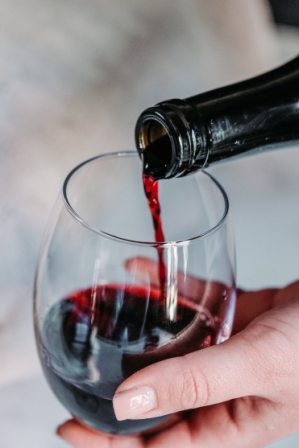There are times I think people view me as the “food police.” Mostly, I get this impression when someone sees me at the supermarket and they abruptly turn their shopping cart and head in the opposite direction. Sometimes when I meet people in the supermarket, the first thing they say is “look I have healthy food in there.”
I am not the food police, really, and nothing could be further from the truth. My reality is I eat mostly healthy food, but I also eat my fair share of not so healthy food. I like to follow the 80/20 rule, if I am lucky the 90/10 rule. Eat 80 percent healthy food, and take it easy on myself for 20 percent of the time. This 20 percent allows me to stay motivated for the remainder of the time. That being said, I want to tell you about the health benefits of something you will have no problem wanting to consume — red wine. There is no badge needed to enforce this recommendation.
 Red wine has been shown to have some amazing health benefits, but before you go out and buy a few cases, let me first tell you what a healthy dose of wine is. If you already drink red wine, do so in moderation and it is recommended that if you don’t drink, do not start for the health benefits alone. According to “Dietary Guidelines for Americans 2010,” published by the U.S. Department of Agriculture, “If alcohol is consumed, it should be consumed in moderation for healthy adults, which means up to one drink a day for women of all ages and men older than age 65 and up to two drinks a day for men age 65 and younger.”
Red wine has been shown to have some amazing health benefits, but before you go out and buy a few cases, let me first tell you what a healthy dose of wine is. If you already drink red wine, do so in moderation and it is recommended that if you don’t drink, do not start for the health benefits alone. According to “Dietary Guidelines for Americans 2010,” published by the U.S. Department of Agriculture, “If alcohol is consumed, it should be consumed in moderation for healthy adults, which means up to one drink a day for women of all ages and men older than age 65 and up to two drinks a day for men age 65 and younger.”
The limit for men is higher because men generally weigh more and have more of an enzyme that metabolizes alcohol than women do. A drink is defined as 12 ounces (355 milliliters, or mL) of beer, 5 ounces (148 mL) of wine or 1.5 ounces (44 mL) of 80-proof distilled spirits. If you drink too much, you will not attain all of the health benefits and could end up with potential health problems instead.
Red wine has many healthy components such as polyphenols and procyanidins, but the shining star of red wine is a chemical called resveratrol, which contributes to many of the health benefits. Many drinks and foods have resveratrol, red wine just has more of it. The following plants and drinks are rich in resveratrol: red wine; grapes; blueberries; raspberries; bilberries and peanuts.
Resveratrol is a compound found in some plants. Plants produce resveratrol to fight off bacteria and fungi. Resveratrol also protects plants from ultraviolet irradiation. Red wine contains more resveratrol than white wine because it is fermented with the skins (white wine is not). Most of the resveratrol in grapes is in the seeds and skin. The positive effects of these chemicals are antioxidant and anti-inflammatory, and they also reduce the stickiness of blood platelets, raise our omega-3 fatty acids and improve certain healthy enzymes.
As you may be aware, red wine has been widely publicized for its heart-healthy benefits, however the more I dove in to the research, the more I learned that red wine’s health benefits go far beyond the heart. It may surprise you that red wine can reduce the risk of depression and prevent colon cancer (by reducing the rate of bowel tumors by approximately 50 percent). Red wine also has anti-aging properties as seen in the longer life spans enjoyed by the people in Sardinia and southwest France. A team from Loyola Medical Center found that moderate red wine intake can reduce the risk of developing dementia. The investigators explained that resveratrol reduces the stickiness of blood platelets, which helps keep the blood vessels open and flexible. This helps maintain a good blood supply to the brain.
Red wine can reduce the risk and help prevent blinding diseases such as diabetic retinopathy and age-related macular degeneration, which is the leading cause of blindness among Americans age 50 and older. These diseases are caused by an overgrowth of blood vessels (angiogenesis) in the eye. Red wine can stop the out-of-control blood vessel growth in the eye that causes blindness.
Red wine also offers protection from prostate cancer. Moderate drinkers experienced a 6 percent reduced risk. Finally, red wine may have some benefits for insulin sensitivity, helping to prevent type 2 diabetes. Red wine may protect the brain after a stroke, improve lung function and help with preventing lung cancer.
That is quite an impressive list. Red wine has not been my go to libation of choice, however after writing this article, I may just rethink that. By the way, if you are thinking of resveratrol supplements, don’t bother. Research finds supplements do not have the same value as drinking red wine.
Lentil Stew with Oranges
The flavors of this lentil dish are brightened with citrus, then deepened with Pinot Noir (a great way to use up any left over wine)
Serves 4
Ingredients
2 tablespoons olive oil
4 ounces Spanish chorizo sausage, thinly sliced (low fat is best or other sausage of your choice)
1 medium onion, peeled and finely chopped
2 cloves garlic, peeled and finely chopped
2 1/4 cups brown lentils, washed and drained
1 cup dry red wine, such as Pinot Noir
2 1/2 cups chicken broth
5 small oranges
1 teaspoon kosher salt
3/4 teaspoon freshly ground black pepper
1/3 cup chopped fresh dill
Directions
1. Heat the oil in a large, deep sauté pan over medium heat. Add the chorizo and cook for 5 minutes or until just browned on both sides. Remove from pan; set aside.
2. Sauté the onion over medium heat for 5 minutes or until soft. Add the garlic and cook 1 minute. Add the lentils and cook over high heat for 2 minutes, stirring constantly. Add the wine and simmer until almost evaporated, about 3 minutes. Add the broth. Bring to a boil, reduce heat, and simmer, partially covered, for 40 to 45 minutes, stirring occasionally, until the lentils are quite tender.
3. Meanwhile, squeeze the juice from 2 of the oranges. Remove the peel and pith from the remaining oranges and slice the flesh into 1/4-inch rounds. Add the chorizo to the lentils and stir in the orange juice. Season with the salt and pepper. Remove from heat and gently fold in the dill and orange rounds.
Tip: This stew can be served cold, too. Combine leftovers with fresh greens for a healthy lunch. To save time, you can substitute 1/2 cup store-bought orange juice for the freshly squeezed.
Dr. Stuart Offer is a Vermont health coach and educator.
 Related Articles & Free Subscription
Related Articles & Free Subscription
Do You Need to Take a Dietary Supplement?






Comment here